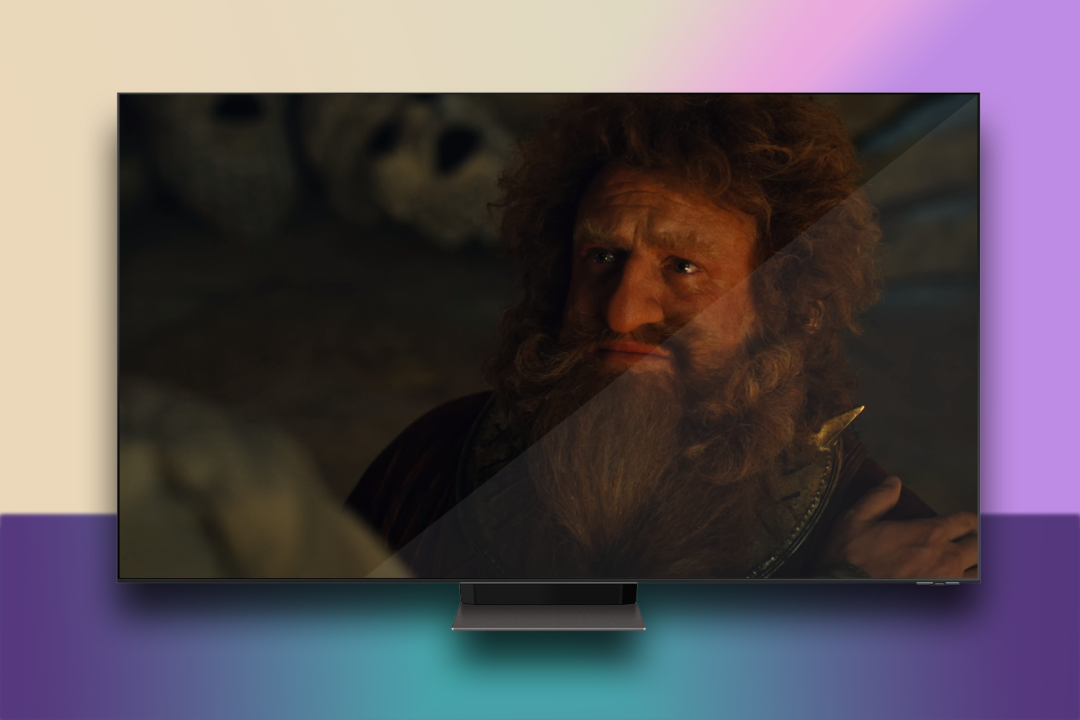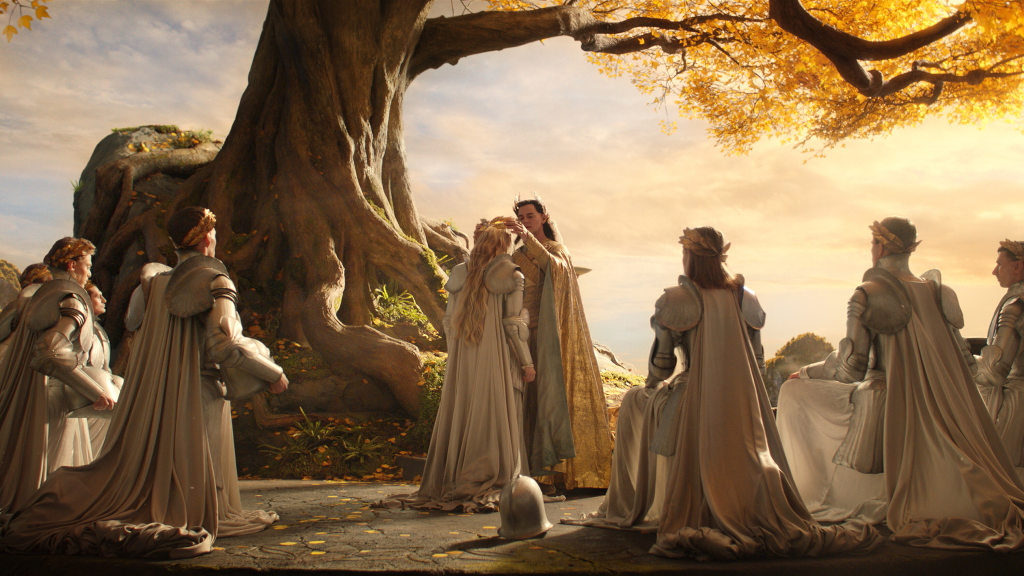Rings of Power in 8K verdict: dwarf hair has never looked crisper
We take Amazon’s new fantasy show for a pixel-packed spin - does 8K do it justice?

Before the crushing adult responsibilities of nursery fees, energy price caps, and rising interest rates infiltrated my brain, I could have easily told you the fastest route to get from The Shire to the Dead Marshes without hesitation. Now, I have to look it up, but it’s not so bad — travel south, along The Green Way, then further down the aptly-named North-South Road. A quick trek east through Rohan (mind the surly Rohirrim/Horse-lords), and boom, Dead Marshes, Mordor, the whole gloomy shebang. Easy.
With a map of Middle Earth on my bedroom wall, Peter Jackson’s masterpieces in cinemas, and multiple copies of the books, I was a certified “Ringer” during my teenage years. Despite this, I first met the announcement of Amazon’s new Rings of Power series with trepidation — after the far-from-perfect Hobbit trilogy came along and sullied everything, I wasn’t sure if I could face another disappointment. But then Samsung asked me if I wanted to borrow a QN700B 8K TV to watch an exclusive native 8K Rings of Power trailer. And obviously, I said yes.
Setting up an 8K TV and writing about a single one-minute and 55-second trailer alone didn’t seem like enough justification for a whole article though. So in addition, I’ve been watching the series each week, upscaled from 4K to glorious 8K, to get a taste for what it’s like living with all those extra pixels. In short, Tolkien’s fantasmical universe is clearer and crisper than it’s ever been, but that still doesn’t mean most people should rush out and snap up an 8K telly right now. But we’ll get on to that in a bit.
Rings of Power: in true 8K
The only truly native 8K Lord of the Rings experience at the time of writing is Samsung’s 7680 × 4320 8K YouTube trailer. Obviously, given the nature of streaming, it won’t be as pure as a physical media experience, but that niggling thought left my head the second the sweeping vistas filled the screen. Think what you will of Amazon’s adaptation, but you won’t find anyone critical of its stunning cinematography.
There’s not much you can say about a two-minute trailer without deep-diving into Tolkien’s deep lore-filled bible, The Silmarillion (and boring you to tears in the process), so I’ll stick to the visuals. Having watched the trailer multiple times on both a 55in 4K and 55in 8K TV, there’s no escaping the extra crispness and detail found in 8K.
Scenes showcasing details like wind-blown grass and Durin’s beard, in particular, really highlight the finer details you get with all those extra pixels. That’s not to say that it looks bad in 4K, mind, but if you’re reasonably close to the screen, it’s impossible not to notice the extra sharpness on offer. It’s so crisp, in fact, that after re-watching the trailer multiple times and ogling at the beauty of Middle Earth in such high definition, I spent the remainder of my evening trawling through all the 8K YouTube videos I could find. Pro-tip — clips with animals really show 8K off at its best. The definition in the fur of a lion or the hypnotic, gleaming striations in a cat’s iris are some of the best 8K examples you can currently find. But I digress.
Rings of Power: upscaled from 4K to 8K

Given the fact that no TV shows or films are currently being streamed in native 8K, we have to place ourselves at the mercy of each manufacturer’s processor tricks to upscale 4K content to 8K. High-end sets from LG, Sony, and Samsung use upscaling to help ensure that content doesn’t end up looking like a grainy mess when being displayed on a screen with so many more pixels than their native resolution.
In this particular experiment, the 4K to 8K conversion is taken care of by Samsung’s fancy AI-powered chip — the convolutedly-named Neo Quantum Processor 8K LITE. Given that it’s not the full-fat processor found in its pricer flagship 8K TV line-up, I had my trepidations, but I’m happy to report that to the naked eye, upscaling is a veritable triumph.
There’s a noticeable difference between watching the show on a native 4K TV compared to its upscaled 8K equivalent. It’s not going to blow you away immediately like the difference between Full HD and 4K, given that 4K is already sharp. But paying attention to the fabric of elvish robes, the plaited hair of dwarves, the streaks of mud on a Harfoot’s face etc. you do notice an extra depth to the details in the upscaled version, and it’s very much appreciated.
It’s so clear in fact, that I found it borderline distracting at times. Between the CGI settings and ultra-clear shots, I feel like I’m constantly being reminded that this is all a production, and being pulled out of the immersion. It’s small things, like noticing, for example, old wooden doors that look too much like perfect theatre or stage props for me to take seriously. This is mostly to do with the production of the show itself, of course, and is something that I also noticed in the 4K version as well. It’s just a little more prominent in 8K as the details are just that little bit sharper. Oh, and don’t get me started on the crazy high levels of background blur, which make certain scenes look like you’re watching a YouTuber in a studio. But that’s a whole other story in itself.
Before diving into this experiment, I was also worried about the effect that AI upscaling would have on creating any unsightly artefacts, but thankfully there were no such distractions. Very occasionally, if a character is running across the screen, I’ll notice a hint of blur surrounding them as the AI engine works its upscaling magic on a fast-moving object, but that’s about it. Even then, I really had to stare long and hard and look for it before I could see it. The overall experience is delightfully crisp, and smooth enough to not even realise any fancy upscaling trickery is happening in the background at all.
Should I buy an 8K TV?

This was a fun experiment, and I’m glad I’ve been lucky enough to enjoy what’s turned out to be a great show in a unique format that not many people can currently experience. But is it going to make me run out and splurge out on an 8K TV? Read the opening line of this article and have a guess.
Ultimately, I think the premium price of 8K TVs, coupled with the lack of native 8K content, means that they’re not at a stage where I think most people should buy them. With a few exceptions. If you’re in the market for a new TV and tend to use the same set for at least five to seven years (or more), then you’ll have no regrets future-proofing yourself if you’ve got the budget and are in the market.
If you’re looking to upgrade your existing setup to a larger screen, then having all those extra pixels at anything 65-inches and above, will also be a very worthwhile investment. The pixels on a 4K screen can start to wear a little thin at the much larger end of the spectrum, with a noticeable loss in sharpness compared to 8K.
If, however, you’ve got a faithful 4K set currently serving you well, then enjoy it for a few more years while the overall prices become more palatable. Now if you’ll excuse me, I’ve got some lembas bread to bake…
- Read more: 4K vs 8K: Ultra HD TV tech explained



